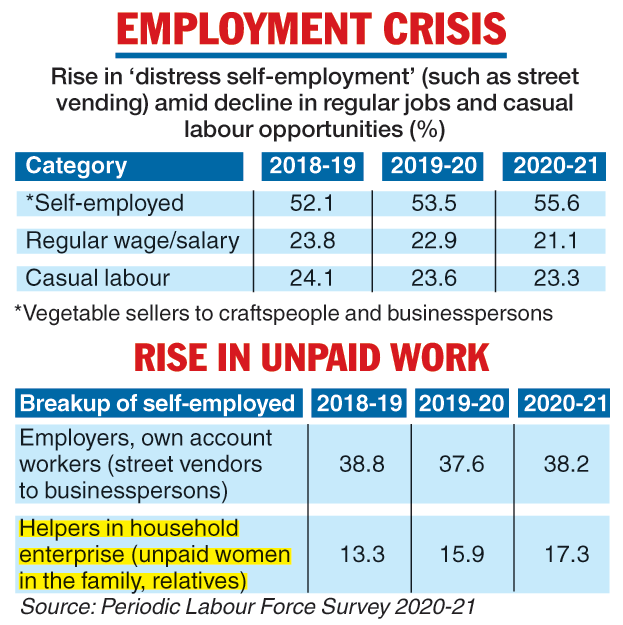A government survey shows a fall in the unemployment rate, or the proportion of the unemployed among the workforce, from 5.8 per cent in 2018-19 to 4.2 per cent in 2020-21.
It also shows a rise in the workers’ participation rate (WPR), or the proportion of the employed in the working-age population, from 35.3 per cent in 2018-19 to 39.8 per cent in 2020-21.
But the survey’s small print suggests a deterioration in the quality of employment, discouraging the drawing of any rosy picture. The data shows a fall in the proportions of salaried workers and casual labourers, implying substantial losses of regular jobs, and a rise in the “self-employed”.
Labour economists said all this points to a trend towards “distressed employment” — such as a formerly salaried worker being forced to turn to street vending — and unpaid labour, such as a formerly working woman now helping out with a family enterprise like farming or a small business without a salary.
Such unpaid workers and street vendors count among the “self-employed” in the terminology used by the Periodic Labour Force Survey (PLFS) for 20-21, released by the National Statistical Office under the ministry of statistics and programme implementation. (See chart)

The survey shows the proportion of the self-employed rising from 52.1 per cent in 2018-19 to 56.6 per cent in 2020-21 under the “usual status” method of counting, mainly driven by an increase in those engaged in family enterprises from 13.3 to 17.3 per cent.
Under the usual status method, people are considered employed if they had more than 30 days of work in the preceding 365 days. Under the alternative “current weekly status (CWS)” method, people are considered employed if they had more than an hour’s work in the preceding week.
Internationally, the CWS is considered a better method as the recall period is shorter, and the PLFS uses both methods. But in India, it’s the figures yielded by the usual status method that are normally used officially.
Using the usual status, the PLFS found the unemployment rate declining from 5.8 per cent in 2018-19 to 4.8 per cent in 2019-20 to 4.2 per cent in 2020-21. The unemployment rate had hit a four-decade low of 6.1 per cent in 2017-18.
Using the CWS method, the unemployment rate came out at 7.5 per cent in 2020-21 against 8.8 per cent in 2018-19 and 2019-20.
Labour economist Santosh Mehrotra, visiting faculty at the University of Bath, said that any positive impression the government may have tried to create about jobs by highlighting the fall in the unemployment rate and the rise in the WPR should be taken with a pinch of salt.
“Self-employment has increased and the share of regular wage or salary workers has declined. Within the self-employed category, the percentage of unpaid workers has increased,” he said.
“The most vulnerable are those engaged in unpaid family work. The PLFS 2020-21 shows an increase in distress-driven, poor quality employment.”
Mehrotra said the quality of employment had suffered because of the economic slowdown caused by the November 2016 demonetisation, hasty implementation of the goods and services tax in 2017, and the national lockdown after the Covid outbreak in 2020.
“Regular jobs have declined in the formal sector, so people have moved into (kinds of) self-employment where the income is low,” he said.
Mehrotra said the best jobs were regular and salaried jobs in the formal sector with social security, and the second best were informal jobs that brought regular salaries or wages but without social security.
He added that the most vulnerable jobs belonged to casual workers working on others’ farms or companies against daily or weekly wages, and those engaged in unpaid work in family enterprises — mostly women.
“Given a choice, people would prefer regular jobs over such kind of self-employment,” Mehrotra said.
Labour economist Amit Basole, a faculty member at Azim Premji University, said the rise in self-employment signified a falling back on the already crowded agriculture and street vending sectors. He said that only a very small proportion among the self-employed - perhaps two to three per cent - were well-to-do businesspersons.
“Most of the self-employment means falling back on agriculture or running a cart or a small business. The income is much less compared with regular jobs,” he said.
“There are already a lot of people in these segments. The entry of more people leads to a sharing of the income, which means that those already in this sector witness a reduced income. This is not a sign of a vibrant employment sector.”
Basole said such a situation was expected since Covid-induced restrictions had reduced regular jobs.
Labour economist K.R. Shyam Sundar, professor of human resource management at the XLRI, Xavier School of Management, said the increase in the percentage of people engaged in unpaid family enterprises was a clear sign of “distress” in the job sector.
“The government can claim some comfort in terms of the improvement in the unemployment rate and the WPR, but the labour market remains in distress,” he said.
“The urban unemployment rate is 6.7 per cent according to the usual status and 10.1 per cent according to the CWS.”
Sundar said the share of agriculture in employment had increased from 44.1 per cent in 2017-18 to 46.5 per cent in 2020-21.
“In a developing economy, non-farm employment should increase,” he said.
Sundar said that nearly two-thirds of the salaried workers had no written contract with the employer while a little over half such workers had no social security.
The PLFS surveyed 100,344 households — 55,389 in rural areas and 44,955 in urban areas — from July 2020 to June 2021. The number of people surveyed was 410,818 — 236,279 in rural areas and 174,539 in urban areas.










